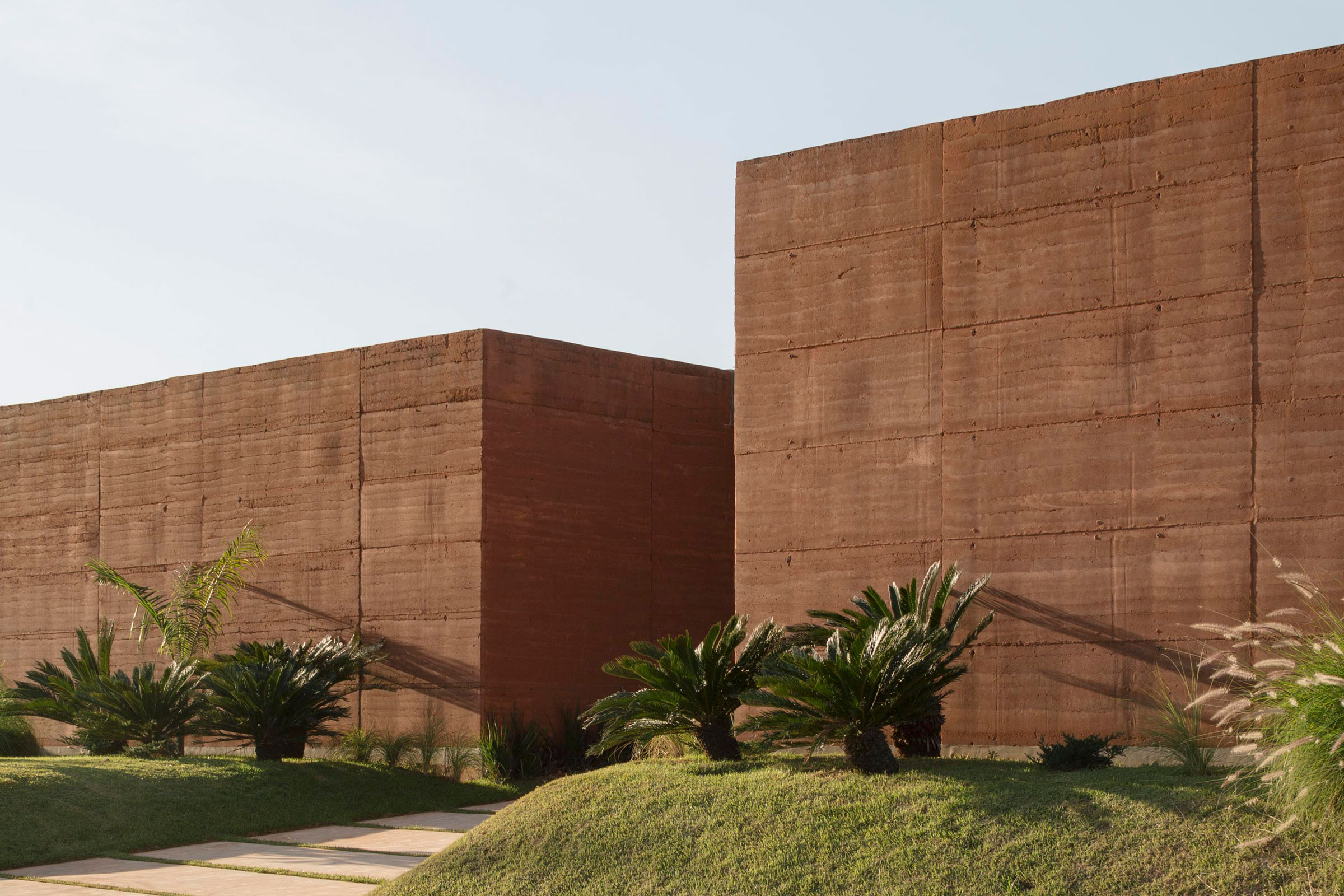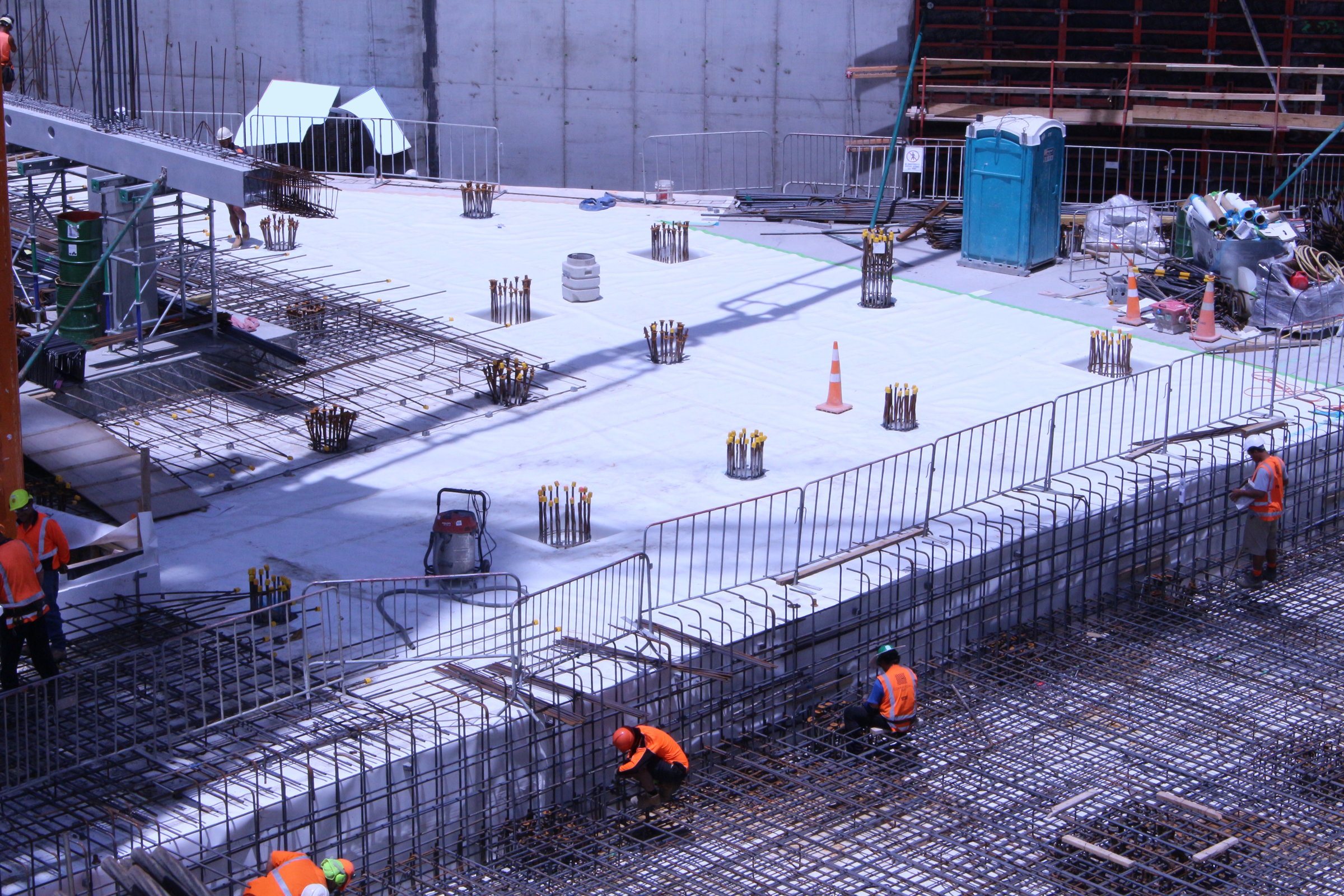Story at a glance:
- Biophilia refers to humanity’s innate biological need to connect with the natural world.
- Biomimicry describes the process of solving complex technological challenges by emulating established biological systems and models.
- Both biophilic design and biomimetic design can be implemented within the built environment in a variety of ways.
Anyone who’s kept up with the sustainable design movement over the last several decades has probably heard of biophilia and biomimicry, at least in passing. Both concepts fall under the category of bio-inspired design and have become popular in response to the growing demand for a greener, healthier built environment.
While they share some similarities, biophilic design and biomimetic design ultimately serve different functions and aim to achieve different goals. Understanding these differences can help us leverage both to their fullest potential for the benefit of all living things.
In this article we’ll examine the differences between biophilia and biomimicry, explore each concept in-depth, and take a look at a few real world examples of each.
What’s the Difference Between Biophilia & Biomimicry?
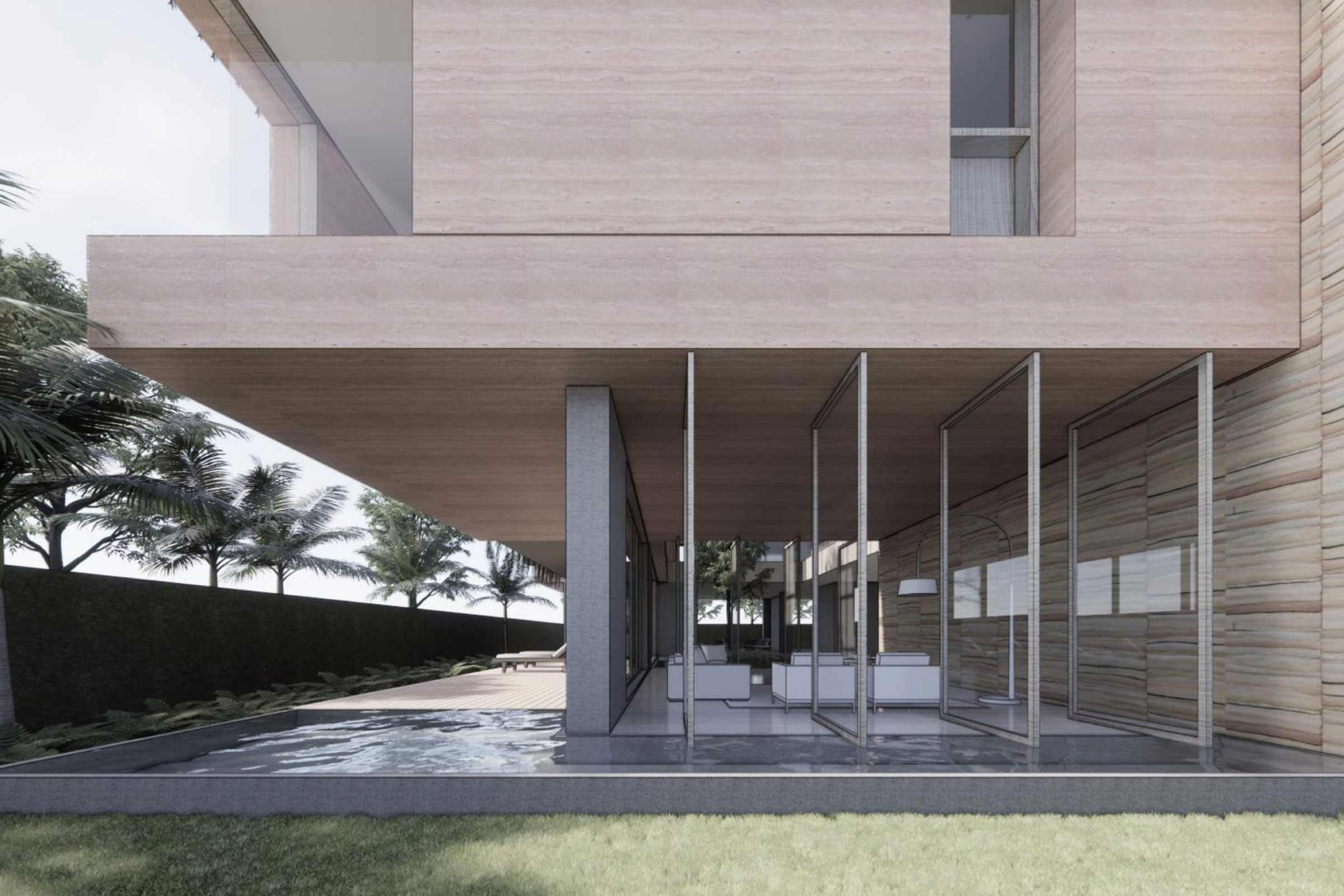
Biophilic design aims to improve occupant health and well-being by fostering meaningful connections to nature while biomimicry looks to solve technological challenges by mimicking biological processes. Rendering courtesy of B+H Architects
Despite both taking inspiration from the natural world, biophilia and biomimicry are fundamentally separate concepts with separate goals.
- Biophilia. Refers to humanity’s innate emotional and biological need to meaningfully connect with nature; biophilic design looks to reestablish this connection between humans and the natural world to improve health and well-being by directly or indirectly invoking nature through intentional design choices in the built environment.
- Biomimicry. A method of innovation that seeks to solve complex human problems by consciously mimicking the natural processes, models, and systems that address similar biological challenges and emulating them as technological solutions; biomimetic design leverages millions of years of evolution to develop sustainable, life-friendly solutions that are energy, water, and resource efficient.
Of course that’s not to say that biophilia and biomimicry never overlap. Design strategies can—and often do—emulate a natural process while at the same time strengthening an individual’s connection to the outdoors. A building that utilizes a passive ventilation system inspired by termite mounds, for example, is practicing both biomimetic design by mimicking a natural system as well as biophilic design by connecting occupants with the outdoors via natural airflow.
Now that we have their baseline definitions and differences sorted, let’s take a more in-depth look at these two design concepts.
What is Biophilia?
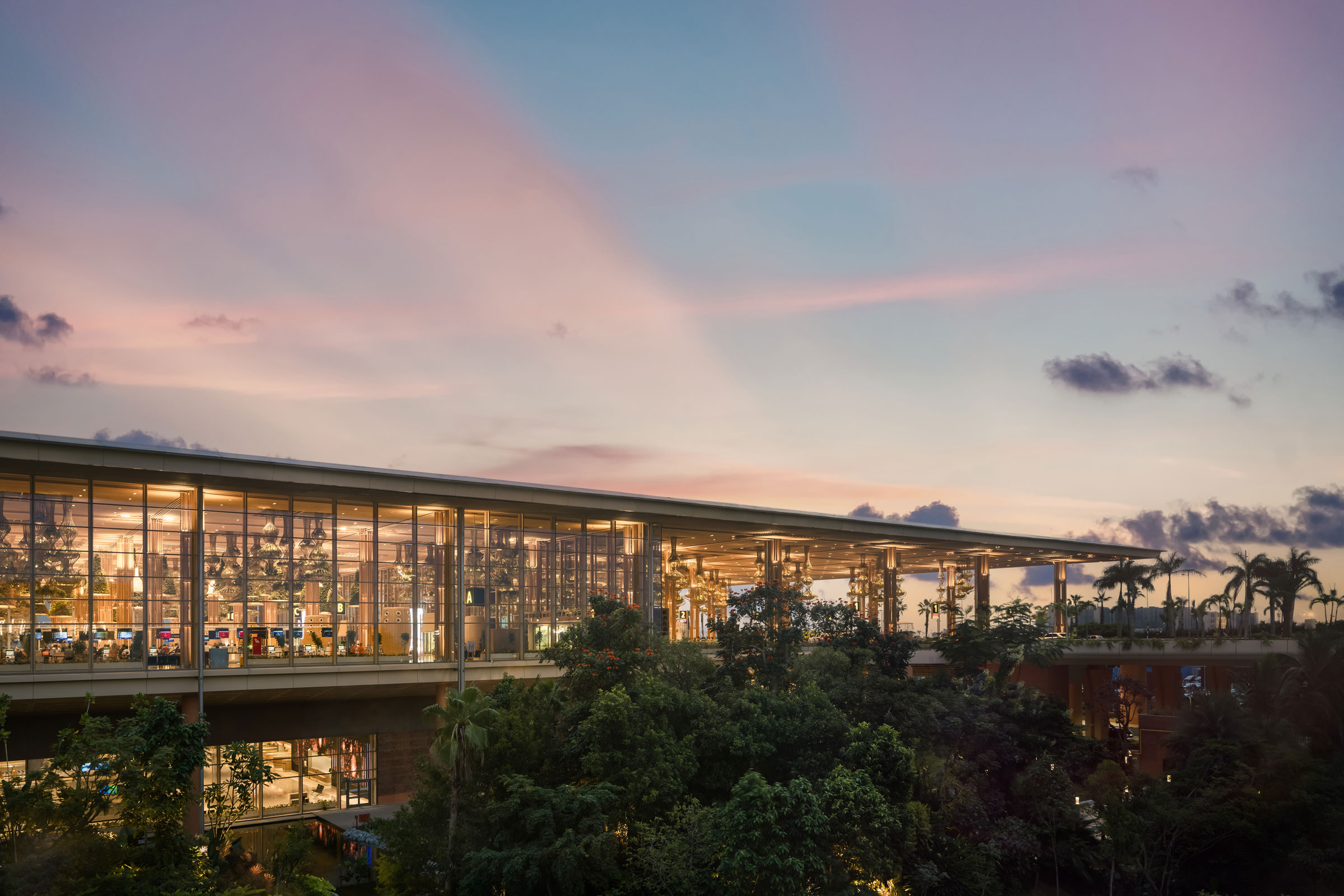
Biophilia posits that a meaningful connection to nature is a biological need just as important as food or water. Photo by Ekansh Goel, Studio Recall
Biophilia as a concept and philosophical viewpoint was first popularized by psychoanalyst Erich Fromm in his 1973 book, The Anatomy of Human Destructiveness, wherein he defined biophilia as being “the passionate love of life and all that is alive.” In 1984 biologist Edward O. Wilson’s Biophilia took this definition a step further, suggesting that a connection with the natural world is inherent to ensuring a healthy, fulfilling existence and can be considered a biological need, no different to that of food or water.
In architecture and engineering, biophilia—or more accurately, biophilic design—intentionally seeks to connect a building’s occupants directly or indirectly to the environment and the natural world at large. The implementation of biophilic design principles is intended to foster a greater relationship with nature by promoting positive interactions between people and the environment.
Author Stephen Kellert is often credited as being the one to bring biophilic design into the mainstream, with his 2008 book, Biophilic Design: The Theory, Science, and Practice of Bringing Buildings to Life—co-written by Judith Heerwagen and Martin Mador—helping to lay the framework for incorporating biophilia into the built environment.
Patterns of Biophilic Design
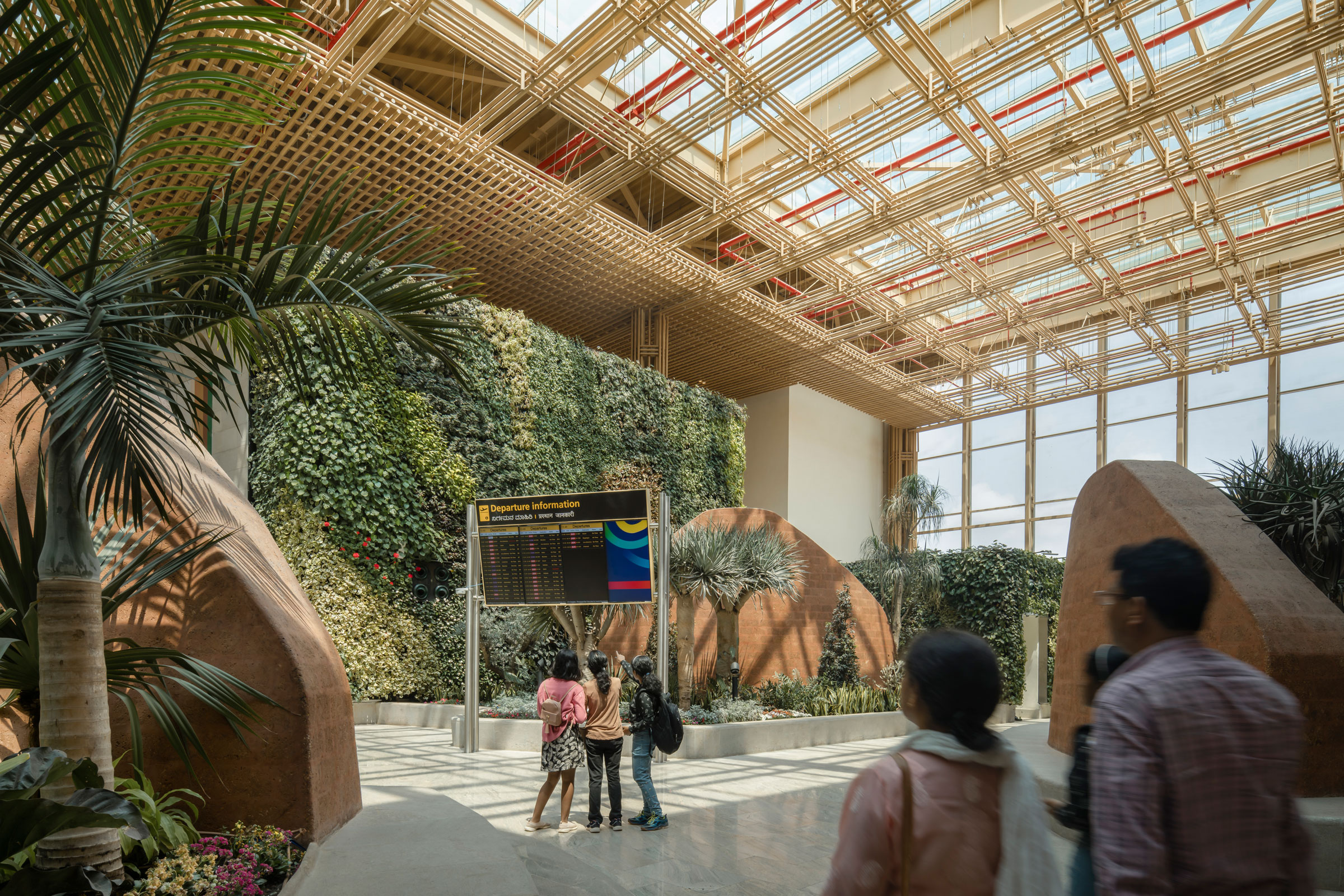
SOM designed the T2 project at Kempegowda International Airport in India to immerse passengers in hanging gardens, surrounded by plants and the soothing sounds of water. Photo by Ekansh Goel, Studio Recall
Using Kellert’s work, Terrapin Bright Green—a leading environmental consultant—has identified 14 core patterns of biophilic design, of which may be separated into one of three distinct groups: nature in the space, natural analogues, and nature of the space. There are seven patterns that fall under the “nature in the space” grouping, of which may be conceptualized as fostering direct connections to the natural world:
- Visual connections. Spaces that establish a visual connection with nature allow occupants to view living systems, elements of nature, and natural processes (e.g. vegetation, living walls, an aquarium, nature photography or artwork, et cetera); based on research that indicates views of nature can help to reduce stress, encourage positive emotional states, and improve cognitive function.
- Non-visual connections. Refers to the haptic, olfactory, auditory, and gustatory stimuli used to deliberately invoke or reference nature, natural processes, and biological system (e.g. birdsong, the sound of flowing water, natural ventilation, aromatic herbs or flowers, a fireplace, et cetera).
- Non-rhythmic stimuli. Encompasses any and all sensory stimuli that are ephemeral and stochastic in nature, or stimuli that cannot be predicted precisely but may still be analyzed statistically (e.g. fabric that billows in the breeze, dappled shadows that change over time, the rustling of leaves, reflections of water, et cetera).
- Thermal and airflow variability. Refers to the subtle changes in airflow, air temperature, surface temperatures, and relative humidity that mimic natural environments; spaces with good thermal and airflow variability are active yet comfortable and flexible but still provide a sense of control.
- Presence of water. This pattern recognizes that seeing, hearing, or touching water can positively impact an individual’s experience of a place on an emotional and physiological level; may include active features like fountains and water walls as well as static imagery or representations of water and water bodies.
- Dynamic and diffuse light. Utilizes varying intensities of light and shadow that change over time to simulate conditions found in nature; this pattern prioritizes the admittance of natural daylight but also includes the use of innovative artificial lighting solutions.
- Connection with natural systems. Spaces that foster a connection with natural systems heighten occupants’ awareness of natural or biological processes, such as temporal or seasonal changes (e.g. constructed wildlife habitats, natural patina of materials, simulated daylighting systems that follow diurnal cycles, et cetera).
Natural analogues, on the other hand, are a bit more abstract and look to foster indirect connections to nature. “Rather than literal natural features, representational physical properties of nature can take the form of displayed images of nature, a natural color palette, biomorphic shapes, patterns, and even circadian lighting,” Michelle Beganskas, senior manager of workplace strategy at Ted Moudis Associates, previously wrote for gb&d. “These design elements are meant to mimic aesthetic qualities of nature without actually using the real thing.”
Overall this category includes three patterns:
- Biomorphic forms. Inclusion of shapes, patterns, textures, contours, and even numeric arrangements found in nature that act as symbolic representations of life
- Material connections. Refers to the use of natural materials—like wood, stone, bamboo, leather, et cetera—and color palettes to subtly reinforce a connection with the natural world.
- Complexity and order. Places that succeed in achieving complexity and order are both information-rich and engaging without being over- or underwhelming; this pattern may be incorporated through the use of symmetries and fractal geometries.
The final four patterns are sorted under the “nature of a space” category and are exclusively focused on spatial relationships:
- Prospect. A space that has a good prospect condition emphasizes horizons, unobstructed sightlines, open expanses, and other factors reminiscent of the African savannahs in which we as a species evolved; such characteristics impart a sense of safety, control, and freedom, even if the environment is unfamiliar.
- Refuge. Focuses on providing safe spaces where individuals may withdraw from the main flow of activity for protection, work, rest, or healing; these places of refuge are meant to feel separate from the surrounding environment without being entirely disengaged.
- Mystery. Recognizes that a place needs to entice individuals to explore and travel deeper into their environments by employing features that partially obscure/reveal or through hidden sensory stimuli; based on the idea that people need to be able to both understand and explore their surroundings.
- Risk/peril. Places with a good risk/peril condition have identifiable threats or perceived risks (e.g. transparent floors that trigger the fear of falling) that are in turn rendered inert by the presence of trusted safety features.
Together these patterns can help architects and interior designers craft spaces that foster lasting connections between a building’s occupants and the natural world at large.
Examples of Biophilic Design
The ways in which biophilic design strategies may be implemented in the built environment are incredibly varied and are often influenced by local or regional factors, as shown in the examples below.
Kempegowda International Airport Terminal 2, Bengaluru, India
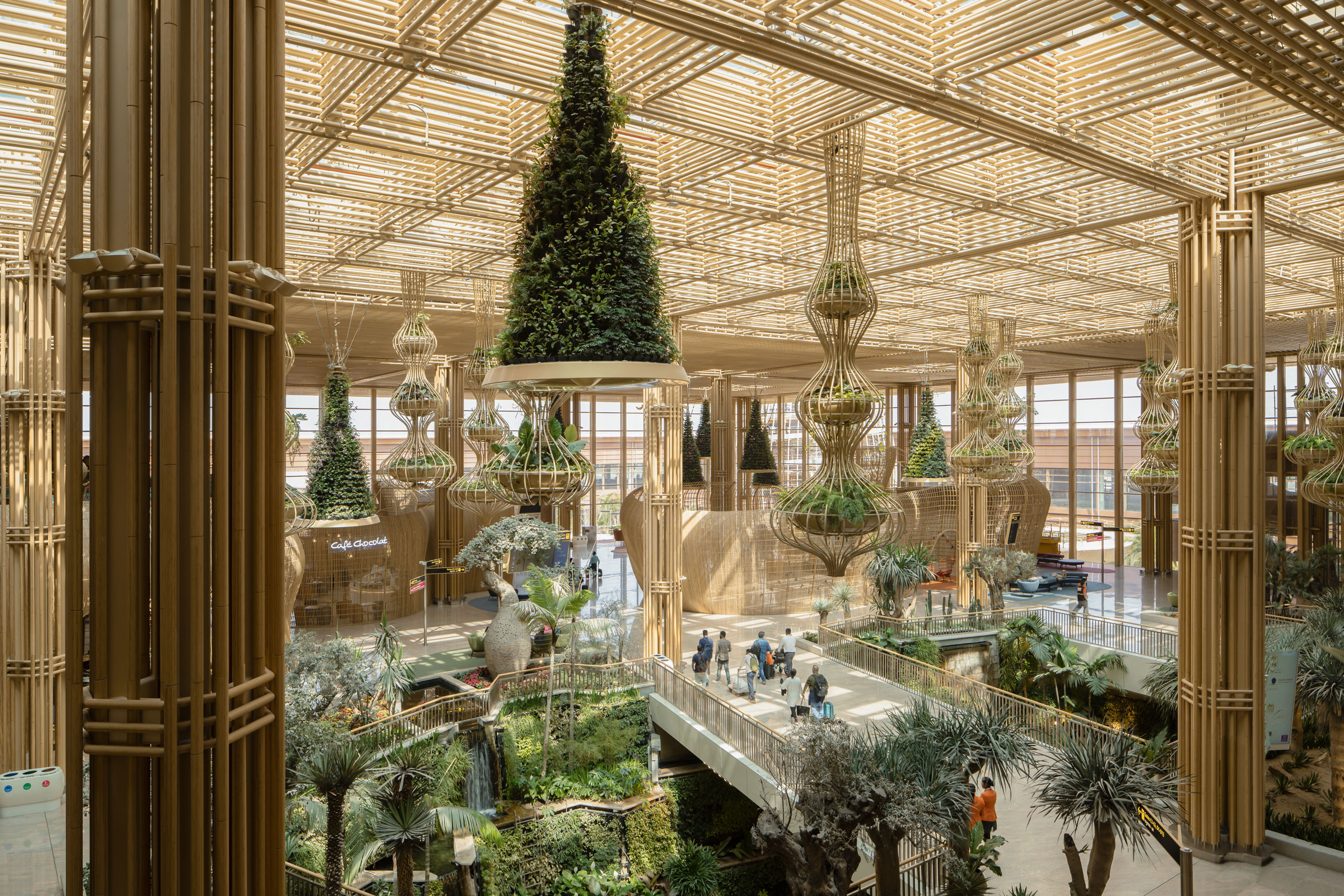
SOM worked closely with landscape architects at Grant Associates and lighting designers at BPI to balance the daylighting requirements of the plants and the energy loads of the Terminal 2 (T2) project at Kempegowda International Airport in India. Photo by Ekansh Goel, Studio Recall
Designed by Skidmore, Owings & Merrell (SOM), the Kempegowda International Airport Terminal 2 (T2) flips the concept of the modern airport terminal on its head and forces us to reevaluate how we think airports should look and feel.
Conceptualized first and foremost as a “terminal in a garden,” T2 was designed from the ground-up with biophilia in mind and the goal of connecting passengers to the natural world along each step of their journey. Hanging gardens greet travelers at check-in while plants, water features, and outdoor walkways can be found in abundance throughout the terminal as a whole. Rather than relying on artificial lighting, most of the terminal is illuminated almost exclusively by natural sunlight that filters in through an extensive network of skylights. All of the vegetation is irrigated with rainwater harvested on-site and indoor waterfalls help passively regulate interior temperatures.
Natural, locally sourced building materials like brick, stone, rattan, and engineered bamboo further reinforce a connection to nature while reducing the terminal’s overall environmental footprint. “We also focused our engineering on reduced embodied carbon and designing a structure that maximizes the use of locally sourced materials,” Peter Lefkovits, design principal at SOM, previously wrote for gb&d. “We designed a small structural grid (only 18 meters by 18 meters) that supports the program spaces needed for 25 million annual passengers. Our smaller grid reduces the material needed and creates a lightness in the structure.”
The Child Care Center, Villeta, Paraguay
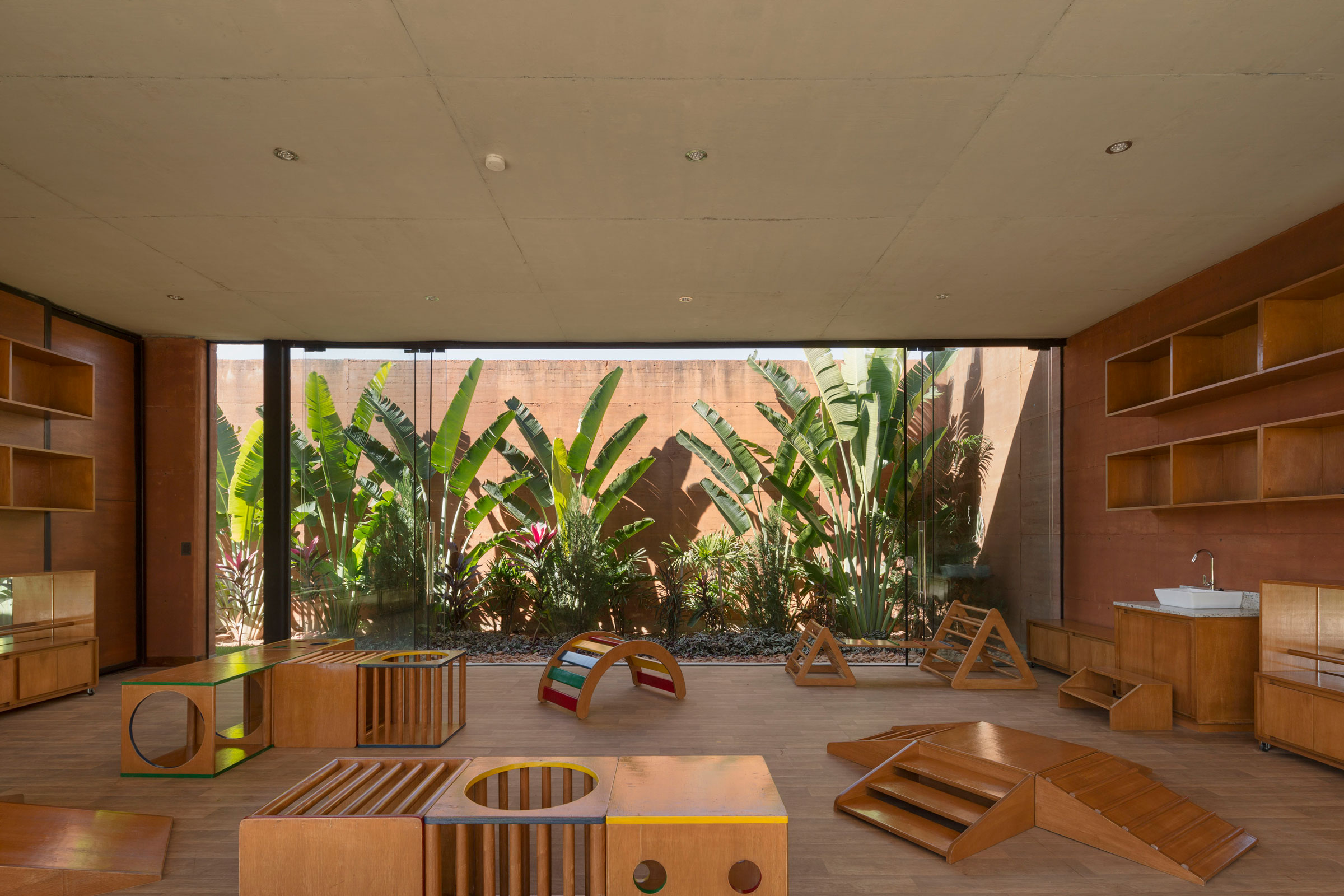
The Child Care Center’s classroom walls open to green courtyard spaces. “We intended to make the experience of the place feel very comfortable and connected to nature,” says Horacio Cherniavsky of Equipo de Arquitectura. Photo by Federico Cairoli
Designed by Equipo de Arquitectura, the Child Care Center in Paraguay aims to encourage independent sensory learning and connect children with the natural world from a young age via biophilic design elements. “We wanted children to be in contact with nature and natural materials at all times,” Horacio Cherniavsky, a founding member of Equipo de Arquitectura, told gb&d in a previous article. “We did not want to create the typical classroom where you feel you are inside a closed space.”
Operating as both a school and daycare, the Child Care Center encompasses two classrooms, a dining room, and an administrative area, each of which is open to the outdoors on two sides. This unique design allows sunlight and fresh air to move through the classrooms, greatly reducing the need for mechanical heating and cooling, ventilation, and artificial lighting. Sliding glass walls may be drawn across these openings during periods of inclement weather, offering protection without obscuring views of the surrounding landscape.
The walls are made primarily from rammed earth and are incredibly resilient—grounding the building within the environment while creating diverse colors, textures, and even smells that enrich the occupant experience. “It’s a sensory type of learning,” Cherniavsky says. “The experience of the space is what helps the child learn from his or her senses.” Indoor plants, courtyard gardens, and green rooftops further reinforce the center’s commitment toward biophilic design, with the latter also helping to mitigate stormwater runoff and passively regulate interior temperatures.
What is Biomimicry?
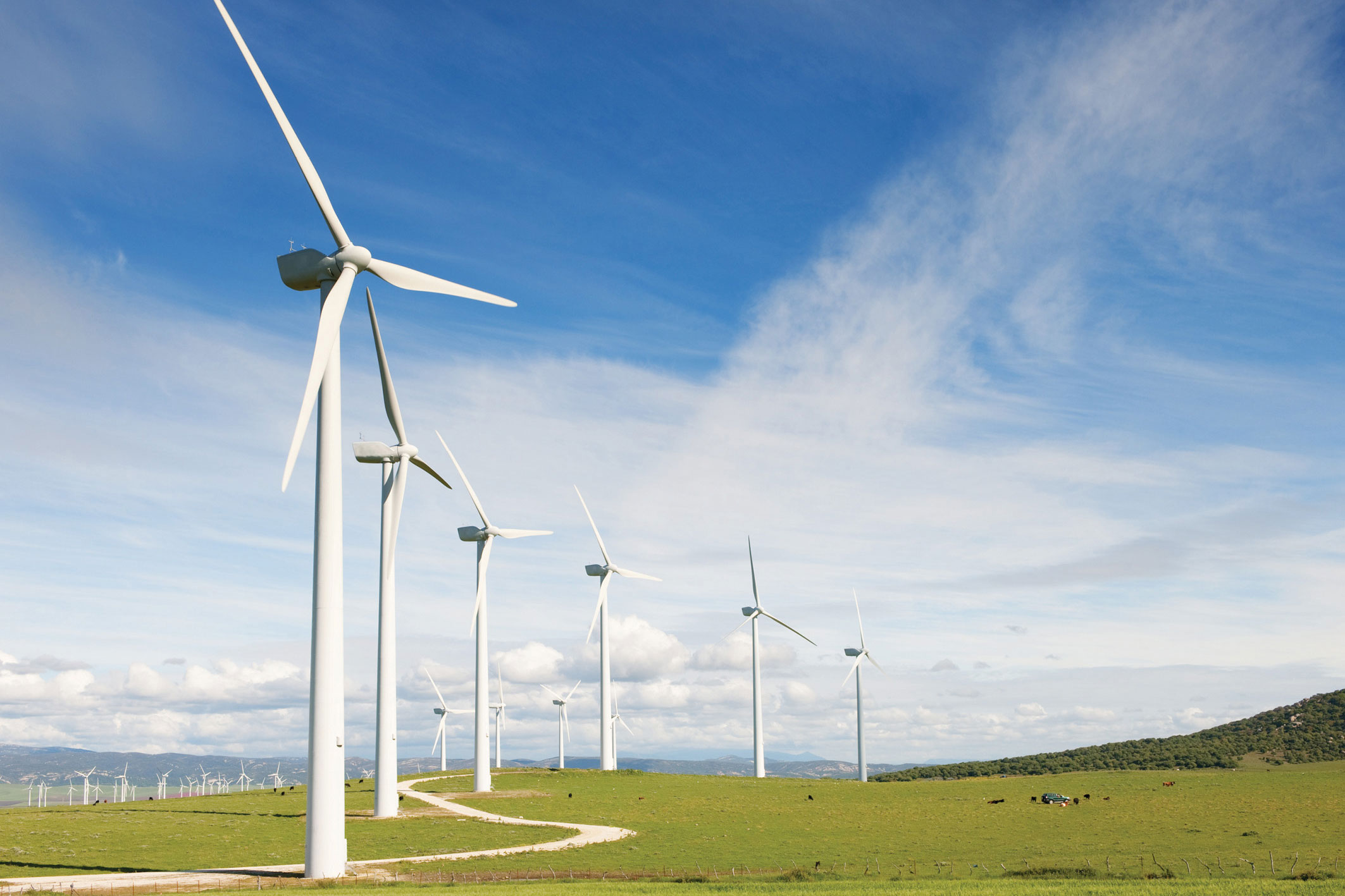
The blades of wind turbines are biomimetic solutions designed to emulate the flippers of humpback whales—their unique shape helps improve their efficiency by reducing drag in the air, just as the whales’ flippers reduce drag underwater. Image courtesy of Covestro
Biomimicry is an approach to design and engineering that looks to emulate the models, systems, processes, and elements found in nature as a means of solving humanity’s complex problems. The Biomimicry Institute defines biomimicry as “an approach to innovation that seeks sustainable solutions to human challenges by emulating nature’s time-tested patterns and strategies. The goal is to create products, processes, and policies—new ways of living—that are well-adapted to life on earth over the long haul.”
In short, biomimicry recognizes that nature has had billions of years to test, improve, and streamline biological systems and processes for maximum energy, water, and resource efficiency, and as such serves as the perfect model, measure, and mentor for devising high-performance, low-waste strategies—especially when it comes to the AEC sector.
“Nature-inspired designs and the practice of implementing systems analogous to those found in the natural world can also promote sustainability and efficiency through well-conceived materials and processes,” Henry Celli, associate principal and senior architect at CBT, previously wrote for gb&d. “By incorporating these methods—known as biomimicry—into architecture, we can achieve a more intuitive approach to regeneration that requires less mechanical intervention.”
Contemporary biomimicry is rooted in biomimetics, a concept developed across the 1950s and 60s by American physicist and polymath Otto Schmitt, who created the Schmitt trigger by studying the nerves of squid and emulating the biological process of nerve propagation. American science writer, innovator, and cofounder of the Biomimicry Institute Janine M. Benyus is credited with popularizing biomimicry following the publishing of her book, Biomimicry: Innovation Inspired by Nature, in 1997.
The current conceptualization of biomimetic design is based on three key concepts: emulate, ethos, and (re)connect.
- Emulate. The scientific, research-based process of observing, learning from, and replicating biological processes, forms, and ecosystems to develop regenerative—rather than neutral or degenerative—designs.
- Ethos. The philosophy of understanding life’s biological processes to create better designs that both support and create conditions conducive to life.
- (Re)connect. Seeks to dissolve the idea that humans are inherently separate from nature, reminding us that we are part of life’s interconnected systems; encouraging us to observe the natural world so we may form a more holistic ethos to better emulate biological strategies in our designs.
Despite their mimicking of biological processes, however, biomimetic designs are not always immediately recognizable as being inspired by nature—a characteristic that sets them apart from most biophilic designs. Modern wind turbine blades, for example, are designed to emulate the flippers of humpback whales, for the same shape that helps reduce drag in the water also helps reduce drag in the air, improving the turbines’ overall efficiency.
The Biomimetic Design Process
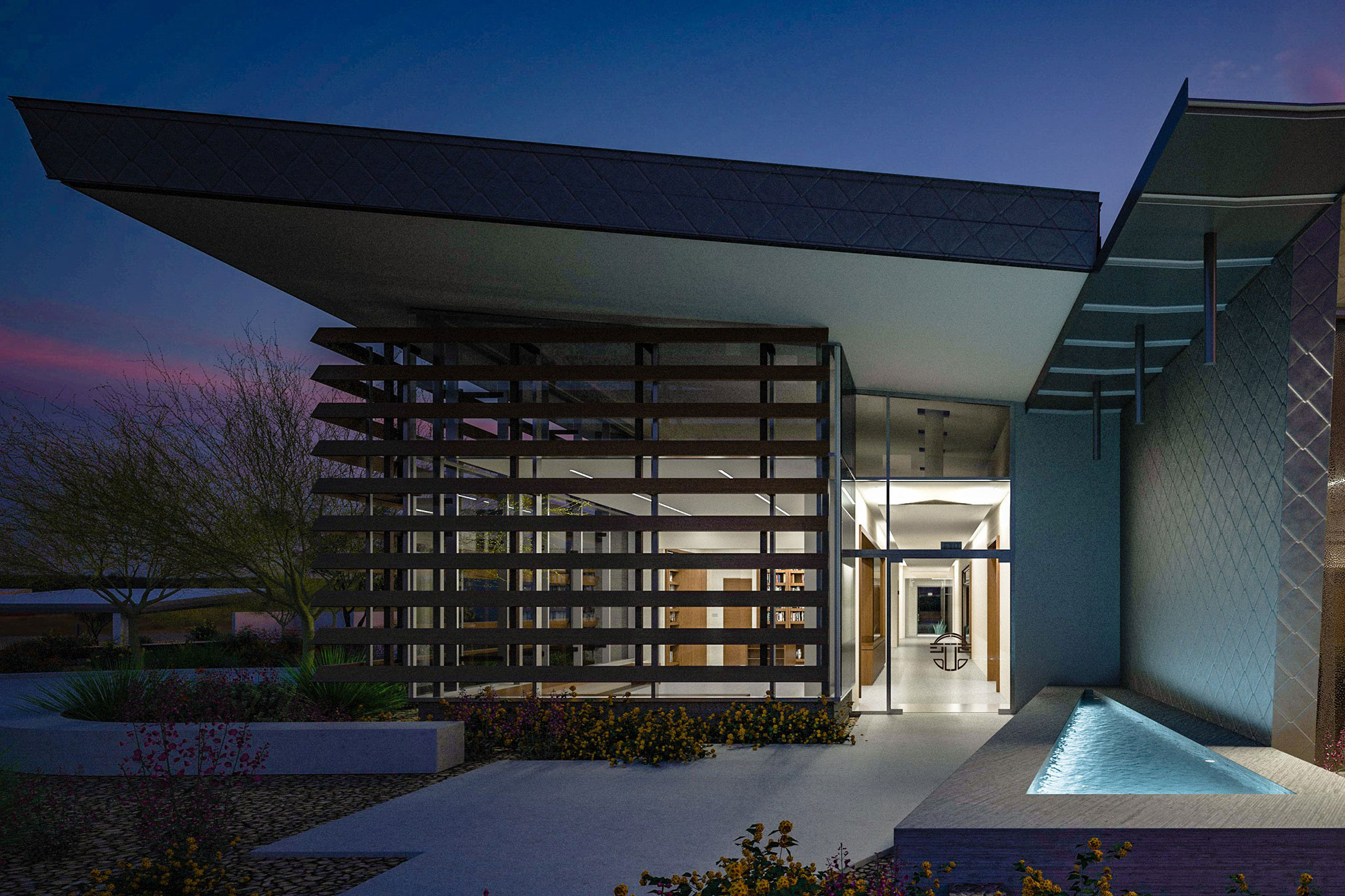
Biomimicry leverages millions of years of evolution to solve human problems by emulating the biological processes, systems, and models. The Biomimicry Institute’s Biomimicry Design Spiral serves as a guiding framework for developing viable biomimetic solutions. Rendering courtesy of Orcutt | Winslow
Where biophilic design has patterns for establishing connections to the natural world, biomimetic design has a process for emulating biological systems and models. This process is based on the idea that nature has already devised a solution to any challenge we wish to solve and it’s simply a matter of finding, understanding, and replicating those solutions.
“Biomimicry shows us first that nature designs solutions to very similar problems as us, with the same basic resources and context, but just with very different processes—packaging, transportation, structures, creating color, moving through fluids, pumps, agriculture,” Jaime Miller, director of biomimicry at B+H Architects, previously wrote for gb&d.
Developed by the Biomimicry Institute, the Biomimicry Design Spiral is a circular six-step process for conceptualizing, formulating, and realizing biomimetic solutions.
- Define. Identify the challenge that needs to be solved, including any criteria and/or potential limitations (i.e. deciding what the design needs to do, for whom, and in what context).
- Biologize. Reframe the challenge in a biological context by identifying at least one “how does nature…?” question that addresses the same issue as the problem you’re trying to solve.
- Discover. Conduct research to find one or more biological processes, systems, or models that answer the “how does nature…?” questions asked during the biologize stage; the Biomimicry Institute’s web-tool, Ask Nature, can help with this step.
- Abstract. Reframe those biological strategies as design strategies without using biological terminology.
- Emulate. Use all of the information you’ve collected thus far to come up with ideas for actually emulating those strategies.
- Evaluate. Assess and evaluate any design concepts created during the previous step to verify whether they are actually feasible and adequately address the design problem you’re trying to solve.
In most cases a viable biomimetic solution will not be identified and developed after only one pass through the Biomimicry Design Spiral, but will instead require multiple rounds of discovery, creation, and assessment. The end result, however, will more often than not be much more efficient than a solution designed using conventional framework.
Examples of Biomimicry
While it has the potential to be implemented in just about any industry and context, biomimetic design is extremely promising within the AEC sector and can be used to improve the energy, water, and resource efficiency of our built environment.
TSG Foundation Center for Spiritual Development Headquarters, Scottsdale, AZ
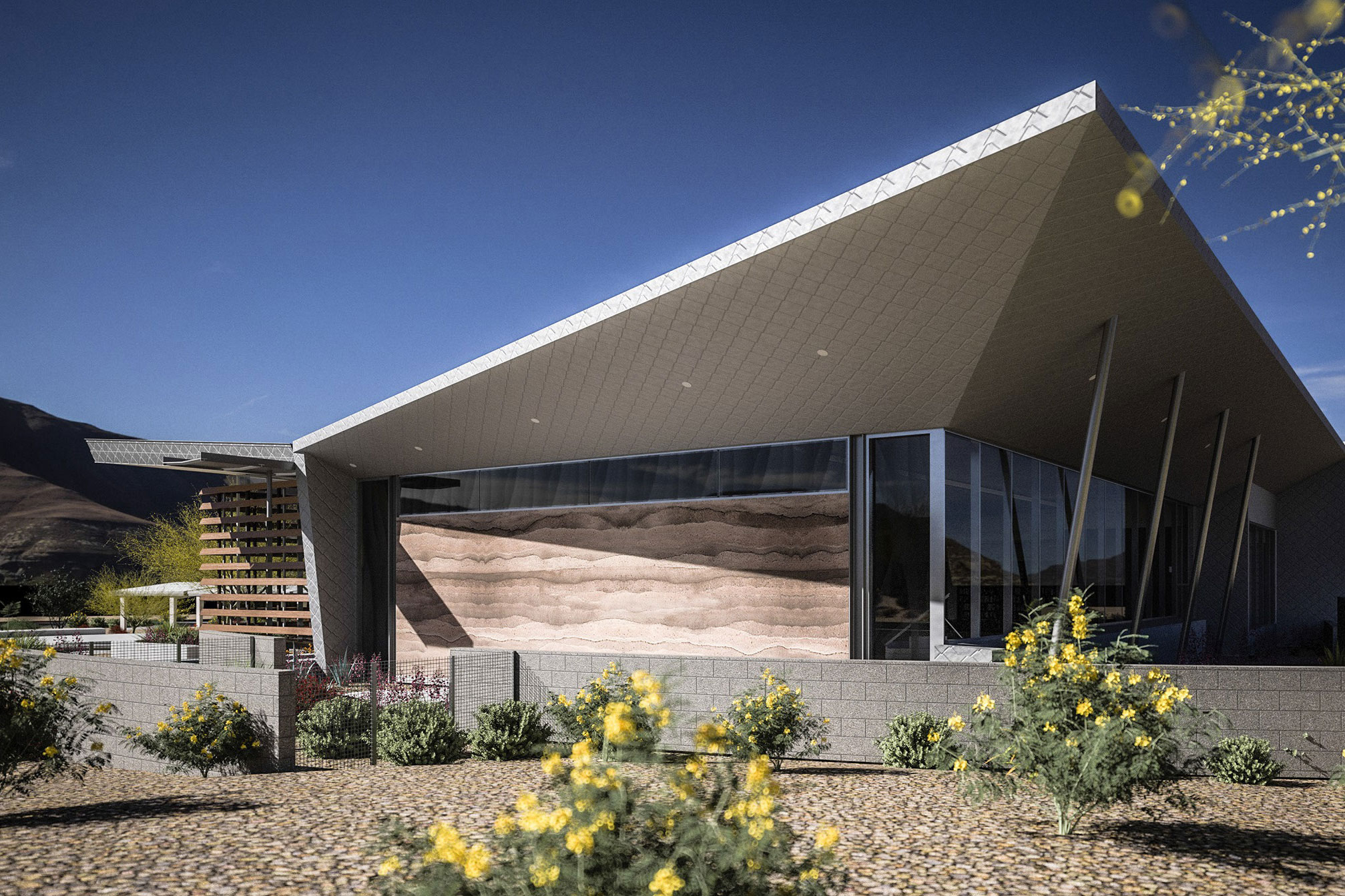
The TSG Foundation’s Center for Spiritual Development headquarters’ exterior masonry is inspired by the form and function of the ribs of the saguaro cactus. Rendering courtesy of Orcutt | Winslow
A prime example of how biomimicry may be applied in the architectural sense is the TSG Foundation’s Center for Spiritual Development headquarters, located within the sweltering, drought-prone Sonoran Desert. Designed by Orcutt | Winslow and built by 180 Degrees Design + Build, the building’s form leverages the fine-tuned biological processes of desert cacti to provide passive cooling and reduce energy usage.
Approximately half of the building’s masonry exterior utilizes the form and function of the saguaro cactus, specifically the cactus’ ribs, or the vertical, accordion-like features found along their trunks and stems. “The naturally occurring form of the saguaro cactus’ ribs are known to function as a cooling mechanism that creates pockets of cooler, shaded air,” Ashley Mulhall, senior associate with Orcutt | Winslow, wrote in a previous gb&d article. “This form of the building’s west facing masonry exterior will aid in cooling the building with no use of additional energy, contributing to one of the project’s passive energy strategies.”
This innovative use of biomimicry—along with the project’s other passive and active energy- saving strategies—has put the center on track for achieving Net Zero Energy and Petal certification through the Living Building Challenge.
India House, Bengaluru, India
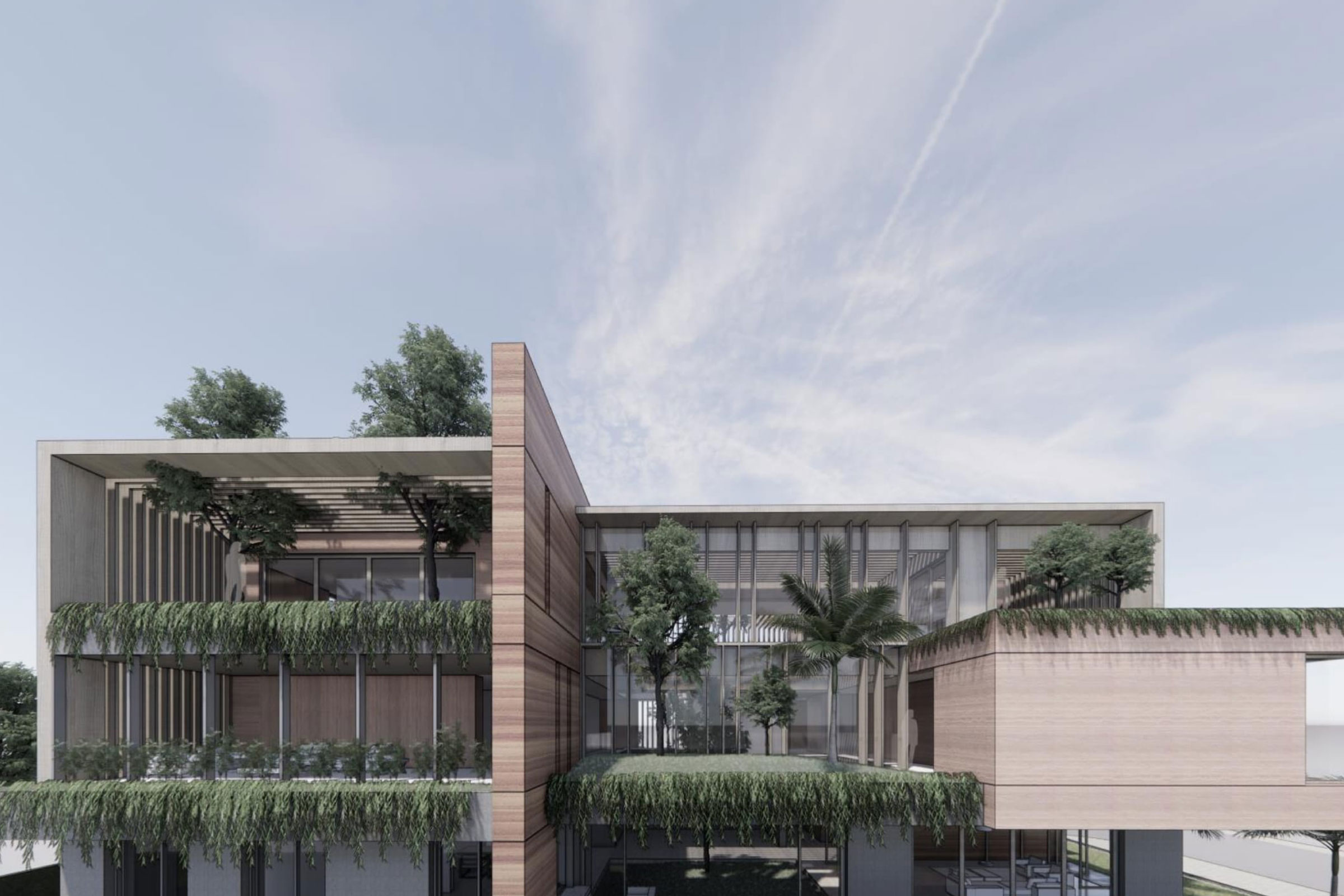
One of B+H Architects’ most comprehensive projects is a biomimetic house design in Bengaluru, India. Rendering courtesy of B+H Architects
Another example of biomimetics in architecture is B+H Architects’ in-progress India House, a single-family residential project that aims to address several base issues. “We stripped the design challenge down to a few key things we wanted the design to do: notably, breathe and self-cool, collect water for periods of drought, and be a contribution to the place,” writes Miller.
To solve the home’s ventilation problem, B+H Architects referenced, perhaps surprisingly, termite mounds. These mounds—which can reach incredible heights of over nine feet—are highly efficient structures whose unique design creates a natural convection current that expels hot air from the tall chimneys while cooler air is pulled in through moist foraging tunnels at ground level. Using these principles the team designed a stack ventilation system to passively regulate interior temperatures and encourage airflow.
The baobab tree and barrel cactus—both incredibly well-adapted to storing large amounts of water for extended periods of time—inspired the design of the home’s interconnected rainwater harvesting system, capable of fulfilling the family’s water needs for 100 days of potential drought.
To reduce the home’s dependency on artificial cooling systems, the design team looked to elephants, whose wrinkled skin allows them to stay cool by capturing ambient moisture for long periods of time. “We abstracted the basic principles of capturing moisture in the cracks and found that a rock wall that harnesses the water from the rain harvesting system would perfectly mimic this idea,” writes Miller. “In doing so we made a very simple cooling technology that was inspired by nature and was also incredibly inexpensive.”

